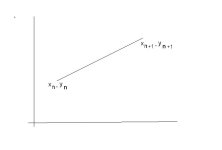Could anybody please tell me what algorithm use following S7-SCL code. I understand it is a value as input then making output. But i want to know what formula it has been used .
FUNCTION FC572 : VOID
TITLE = 'Lookup'
NAME : Lookup
// Block Parameters
VAR_INPUT
// Input Parameters
Input : REAL;
X1 : REAL;
Y1 : REAL;
X2 : REAL;
Y2 : REAL;
X3 : REAL;
Y3 : REAL;
X4 : REAL;
Y4 : REAL;
X5 : REAL;
Y5 : REAL;
X6 : REAL;
Y6 : REAL;
X7 : REAL;
Y7 : REAL;
X8 : REAL;
Y8 : REAL;
END_VAR
VAR_OUTPUT
// Output Parameters
Output : REAL;
Lower_Limit : BOOL;
Upper_Limit : BOOL;
END_VAR
VAR_TEMP
END_VAR
// Statement Section
IF Input <= X1 THEN
Output := Y1;
Lower_Limit := TRUE;
Upper_Limit := FALSE;
RETURN;
END_IF;
IF Input <= X2 THEN
Output := Y1 + ((Input - X1) / (X2 - X1) * (Y2 - Y1));
Lower_Limit := FALSE;
Upper_Limit := FALSE;
RETURN;
END_IF;
IF Input <= X3 THEN
Output := Y2 + ((Input - X2) / (X3 - X2) * (Y3 - Y2));
Lower_Limit := FALSE;
Upper_Limit := FALSE;
RETURN;
END_IF;
IF Input <= X4 THEN
Output := Y3 + ((Input - X3) / (X4 - X3) * (Y4 - Y3));
Lower_Limit := FALSE;
Upper_Limit := FALSE;
RETURN;
END_IF;
IF Input <= X5 THEN
Output := Y4 + ((Input - X4) / (X5 - X4) * (Y5 - Y4));
Lower_Limit := FALSE;
Upper_Limit := FALSE;
RETURN;
END_IF;
IF Input <= X6 THEN
Output := Y5 + ((Input - X5) / (X6 - X5) * (Y6 - Y5));
Lower_Limit := FALSE;
Upper_Limit := FALSE;
RETURN;
END_IF;
IF Input <= X7 THEN
Output := Y6 + ((Input - X6) / (X7 - X6) * (Y7 - Y6));
Lower_Limit := FALSE;
Upper_Limit := FALSE;
RETURN;
END_IF;
IF Input < X8 THEN
Output := Y7 + ((Input - X7) / (X8 - X7) * (Y8 - Y7));
Lower_Limit := FALSE;
Upper_Limit := FALSE;
RETURN;
END_IF;
Output := Y8;
Lower_Limit := FALSE;
Upper_Limit := TRUE;
END_FUNCTION
Thank you.
FUNCTION FC572 : VOID
TITLE = 'Lookup'
NAME : Lookup
// Block Parameters
VAR_INPUT
// Input Parameters
Input : REAL;
X1 : REAL;
Y1 : REAL;
X2 : REAL;
Y2 : REAL;
X3 : REAL;
Y3 : REAL;
X4 : REAL;
Y4 : REAL;
X5 : REAL;
Y5 : REAL;
X6 : REAL;
Y6 : REAL;
X7 : REAL;
Y7 : REAL;
X8 : REAL;
Y8 : REAL;
END_VAR
VAR_OUTPUT
// Output Parameters
Output : REAL;
Lower_Limit : BOOL;
Upper_Limit : BOOL;
END_VAR
VAR_TEMP
END_VAR
// Statement Section
IF Input <= X1 THEN
Output := Y1;
Lower_Limit := TRUE;
Upper_Limit := FALSE;
RETURN;
END_IF;
IF Input <= X2 THEN
Output := Y1 + ((Input - X1) / (X2 - X1) * (Y2 - Y1));
Lower_Limit := FALSE;
Upper_Limit := FALSE;
RETURN;
END_IF;
IF Input <= X3 THEN
Output := Y2 + ((Input - X2) / (X3 - X2) * (Y3 - Y2));
Lower_Limit := FALSE;
Upper_Limit := FALSE;
RETURN;
END_IF;
IF Input <= X4 THEN
Output := Y3 + ((Input - X3) / (X4 - X3) * (Y4 - Y3));
Lower_Limit := FALSE;
Upper_Limit := FALSE;
RETURN;
END_IF;
IF Input <= X5 THEN
Output := Y4 + ((Input - X4) / (X5 - X4) * (Y5 - Y4));
Lower_Limit := FALSE;
Upper_Limit := FALSE;
RETURN;
END_IF;
IF Input <= X6 THEN
Output := Y5 + ((Input - X5) / (X6 - X5) * (Y6 - Y5));
Lower_Limit := FALSE;
Upper_Limit := FALSE;
RETURN;
END_IF;
IF Input <= X7 THEN
Output := Y6 + ((Input - X6) / (X7 - X6) * (Y7 - Y6));
Lower_Limit := FALSE;
Upper_Limit := FALSE;
RETURN;
END_IF;
IF Input < X8 THEN
Output := Y7 + ((Input - X7) / (X8 - X7) * (Y8 - Y7));
Lower_Limit := FALSE;
Upper_Limit := FALSE;
RETURN;
END_IF;
Output := Y8;
Lower_Limit := FALSE;
Upper_Limit := TRUE;
END_FUNCTION
Thank you.





